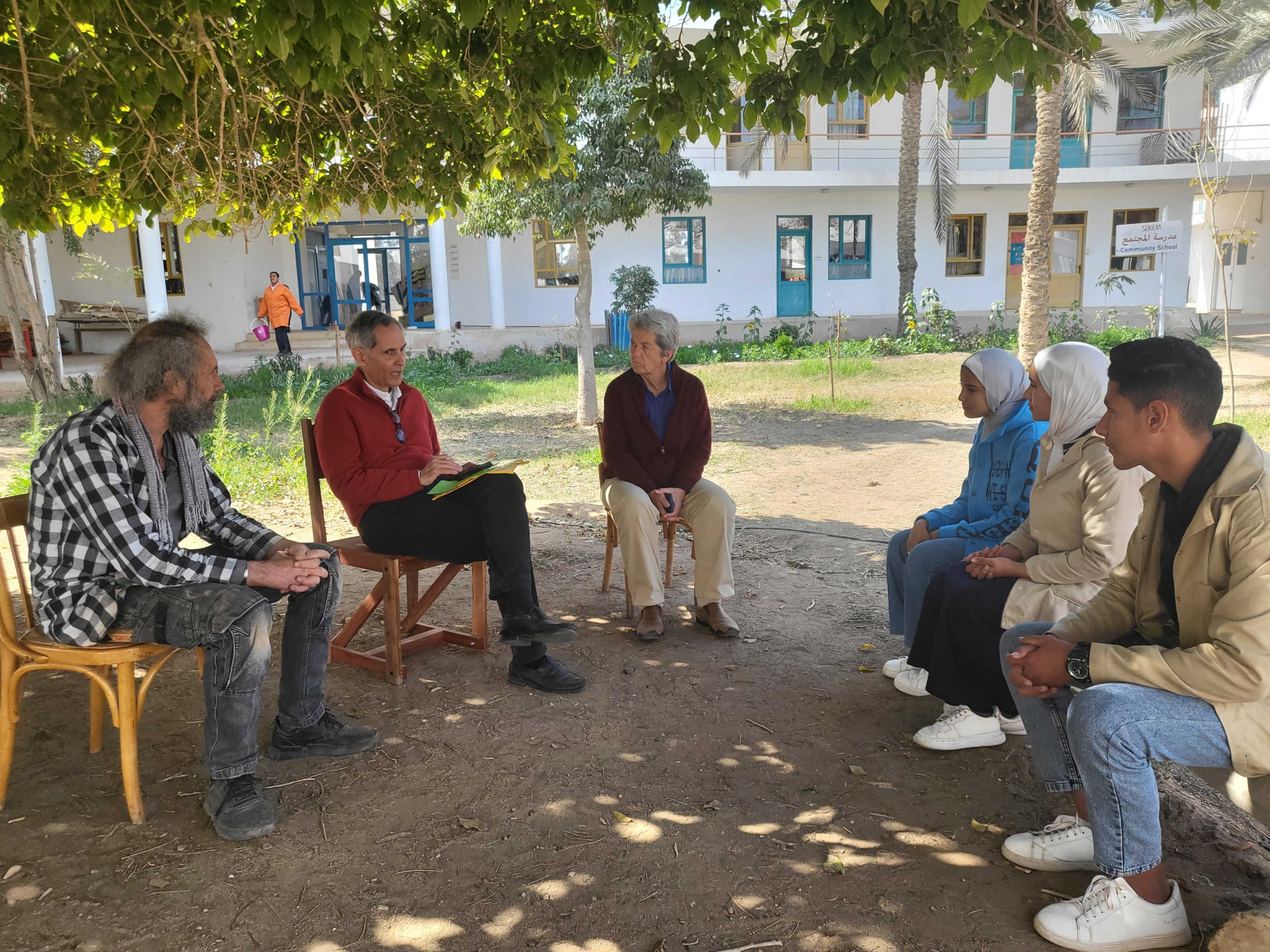The carpentry production and training workshop in SEKEM has a rich history of contributing to building carpentry and furniture production for both internal expansion projects and external markets. Currently, this workshop also serves as a Vocational Training Center (VTC) for young professionals in the field of carpentry. The vocational training got a new impetus in 2012 when carpentry machinery and equipment was brought from Switzerland to Belbeis. The goal was to find a good use for this equipment and acquire support from the professionals. And in this regard, Switzerland, being a country rich in wood, has much to offer. In 2014, Francis Corbat, a Swiss carpenter, came to the SEKEM farm for the first time. The woodwork of the Egyptian carpenters impressed him immediately, and he realized that he can make a contribution himself. Since then, he has traveled to Egypt several times. He also initiated the procurement of additional machines. The most recent one was a block saw that can cut whole tree trunks into boards.
The new block saw cuts whole trunks of hard casuarina wood into boards.
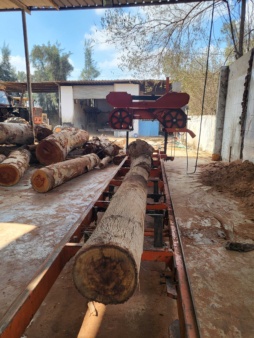
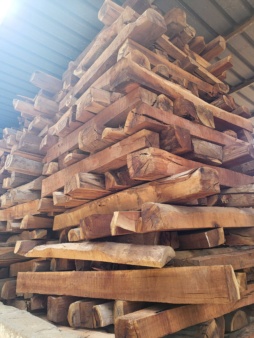
Where does the carpentry workshop stand today? This question holds significant importance as SEKEM is planning a major expansion in the field of woodcraft education with a plan to establish a center of excellence that offers training in woodcraft to the graduates from the VTC as well as for the professionals outside SEKEM. In early 2024, Francis Corbat returned to the SEKEM farm for a month. While Fausi Marti, a longstanding supporter of the training project from Switzerland, visited the farm and held discussions with apprentices, trainers, and project managers. The first part of the article covers the interviews with the trainees.
Conversation with the three students: Salma, Shirihan, and Mustafa
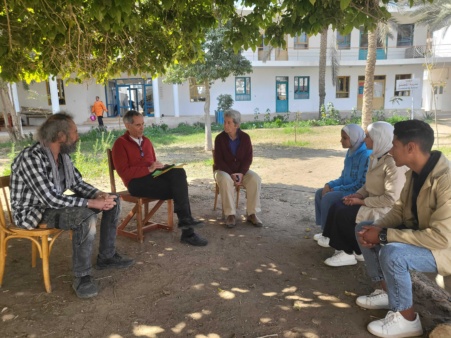
Francis Corbat, Fausi Marti, Angela Hofmann, Salma, Shirihan, Mustafa
Fausi: Please introduce yourselves briefly. How did you come to the carpentry field and what are your future plans?
- Salma: I am from Bassatin which is located near Bilbeis and I am in the first year of my training program. I learned about it through the previous graduates of this program. I enjoy this work: it opens a lot of possibilities in the future. I could imagine myself working at SEKEM in five years or even starting my own carpentry workshop.
- Shirihan: I also come from Bassatin and learned about the training through graduates. I like the versatility of the profession, it includes mathematics and drawing. My dream would be to continue my education at university and become an architect.
- Mustafa: I am also from Bassatin. My siblings have received training here, but not in carpentry. I like the versatility of wooden craft. If I get a good qualification, I might go to a university and become an architect. But my plans are still very open.
Fausi: Earlier, only boys were trained as carpenters. This year, there are more girls than boys. How do you find the training of boys and girls together?
Salma: I believe it’s a positive development. It showcases that both genders are equally capable and willing to take on the responsibilities associated with carpentry.
Fausi: What does your daily training routine look like? Are practical and theoretical lessons well integrated?
- Shirihan: We work in the workshop four days a week. In addition, there are two days of classroom instructions: one day is reserved for professional topics such as drawing, work organization, material science, or technical subjects, the other day is for English, Arabic and religious studies.
- Mustafa: Yes, I find the combination of theory and practice very good. I like that you can apply the theoretical part in the practical work immediately.
Fausi: You have six days of lessons, but you finish every day at half past two in the afternoon. What do you do when you get home?
- Mustafa: I rest, then I have the afternoon prayer (Al Asr Prayer). Often there are homework assignments, math or drawing. Sometimes I also have to help my parents, for example on the farm.
- Salma: For me, Al Asr Prayer comes first, then the homework.
- Shirihan: Al Asr Prayer, of course. Then the homework afterwards, I also have to cook for the family and look after my younger siblings.
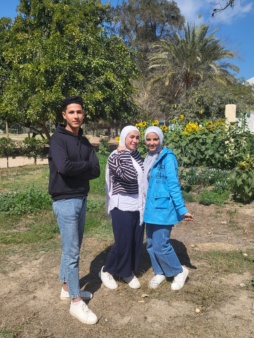
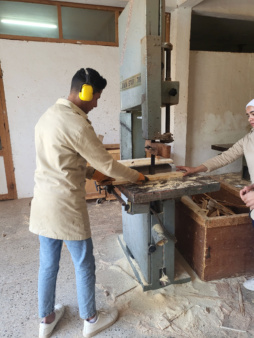
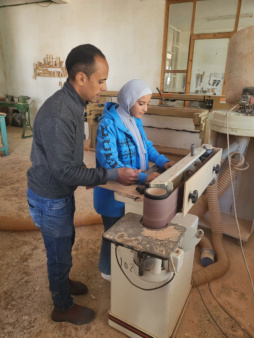
Fausi: What do you like most about your training?
- Salma: For me, I actually enjoy everything.
- Shirihan: I like practical work like sanding or painting. Sometimes we also draw or take part in the designing stage.
- Mustafa: What I like most is making and assembling chairs with Mr. Ali.
Fausi: Shirihan and Mustafa, what does your exam look like? Do you take tests?
- Shirihan: No, we are given a task to make a table or a chair based on a given drawing within a two-day timeframe.
- Mustafa: I think that’s a standard requirement for all Egyptian carpenters to take the test. All training programs in Egypt have to do it the same way.
Fausi: Do you have any suggestions or wishes on how the training could be improved?
- Salma: One small but important thing would be to provide a designated room for girls to store their belongings.
- Mustafa: There should be more options for the exams. Students should have the opportunity to create and craft wooden products according to their preferences.
- Shirihan: We would like to explore work practices in other settings. Why are there no visits or internships at furniture factories or other wood processing companies? I believe this could enrich our learning experience.
Thank you for the conversation and I wish you all the best for your future! To learn more insights about the carpentry workshop from the side of the trainers, read part 2!

